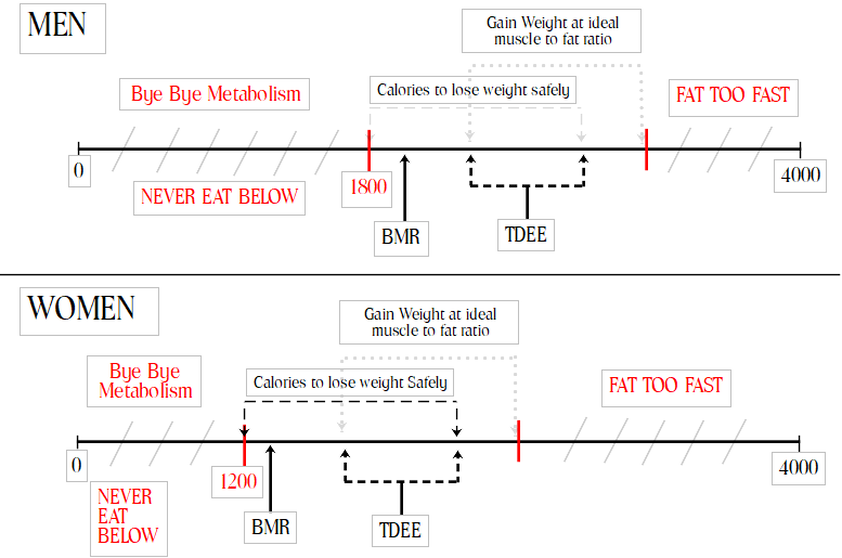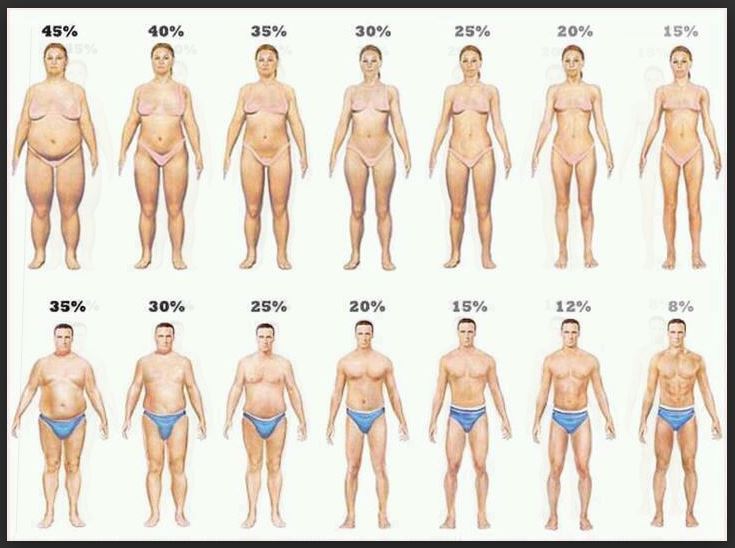LEVEL 2, IIFYM
Calorie Counts and Macronutrients
Before you proceed, you need to know both your Body Fat Percentage and Lean Body Mass. GET A PEN AND PAPER
If you do not know your body fat percentage, go to YouTube and watch a video on how to calculate it or guess from Figure 2 below.
Steps:
If you do not know your body fat percentage, go to YouTube and watch a video on how to calculate it or guess from Figure 2 below.
Steps:
- Convert your Body Fat Percentage to a decimal (divide the percent by 100).
- Multiply your weight by your Body Fat Percentage in decimal form
- Take the number from Step 2 and subtract it from your weight. This is your Lean Body Mass or the weight of everything in your body except fat.
- Convert the number from step 3 to Kilograms by dividing it by 2.2. This is the number you will use to calculate your BMR, below
Comprehensive Calories
Below, you will see an identical calorie scale we saw at the Foundation Level. Unlike the previous scale, this one is a little more descriptive and illustrates more variables than just calories.
Below, you will see an identical calorie scale we saw at the Foundation Level. Unlike the previous scale, this one is a little more descriptive and illustrates more variables than just calories.
There are 2 scales, labeled "Men" and "Women.
Here is the tricky part. In a perfect world, these calculations would work for everyone. Unfortunately, the only way to know how you ACTUALLY compare to the calories you are SUPPOSED to eat is to count your calories for at least a few days and see how your body response (gain weight, lose weight, etc.) My Fitness Pal and Nutritionix are GREAT phone apps to help you with this. You can also use your newly acquired knowledge from level 1 to count your calories as well.
- The dark black line in the center of each scale represents calories (0-4000).
- BMR or Base Metabolic Rate is how many calories your body burns at rest. It is calculated for everyone with this equation => 370 x ( 21.6 x LBM). This is where you plug in your number from above into this equation!
- Total Daily Energy Expenditure or TDEE is how much energy you use outside of your metabolism (i.e. walking, moving at work, etc).
- BMR x Activity Level = TDEE
- TDEE is represented by a range of calories on the scale because it represents the range of activeness that people have. In some cases, that difference can be 1000+ calories!
- Activity Level
- Sedentary (Lazy, don't ever move much) = x 1.2
- Light Activity (heart rate up once or twice a week)= x 1.375
- Moderate Activity (heart rate up once a day) = x 1.55
- Very Active (heart rate pounding once a day = x 1.725
- Badass (heart rate pounding once a day and move around consistently) = x 1.9
- BMR x Activity Level = TDEE
Here is the tricky part. In a perfect world, these calculations would work for everyone. Unfortunately, the only way to know how you ACTUALLY compare to the calories you are SUPPOSED to eat is to count your calories for at least a few days and see how your body response (gain weight, lose weight, etc.) My Fitness Pal and Nutritionix are GREAT phone apps to help you with this. You can also use your newly acquired knowledge from level 1 to count your calories as well.
Undereating/Overeating
- Red means STOP, right? You should NEVER eat below the red calorie marker on the scale (unless a Doctor tells you) or you are going to screw with your metabolism (Bye Bye Metabolism). Likewise, you should never eat WAY more than your TDEE or you are going to gain "fat too fast" for the amount of muscle you will be gaining. As noted in Level 1, +/-500 Calories of your TDEE is a great starting point to lose weight or gain muscle in the best way.
- Again, this scale may not cover the entire population (some people's TDEE is over 4000), but like I said before, it's a great starting point for your understanding of how calories and your metabolism work!
Transforming Your Body
Now that you know the number of calories that you need to consume to support your aesthetic (appearance) goals...
- Lose weight safely (cut)
- Stay the same (maintain)
- Gain weight safely (bulk)


